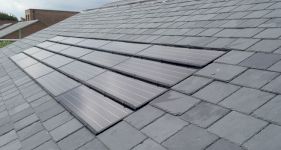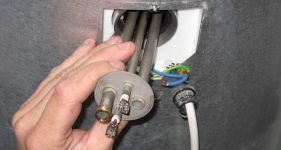Japanese Knotweed Removal Cost
- The average cost to remove Japanese knotweed is £4,000.
- The job will take approximately 1 to 2 days to complete.
- A complete pricing breakdown which includes cost factors to consider, how to identify Japanese knotweed, along with what such a task usually involves.
- How long the job should approximately take, and a general overview of what kind of jobs can be performed.
- How to find and hire a Japanese knotweed removal specialist.
Japanese knotweed is one of the most invasive plants in the UK, and removing it can be complex. Removal costs will vary depending on site size, access, and treatment method.
This guide explains the costs involved with different removal methods, per m² pricing, labour fees, and more. We also show how to find Japanese knotweed removal specialists near you for a free no obligation quote, so you can tackle your knotweed problem with confidence.
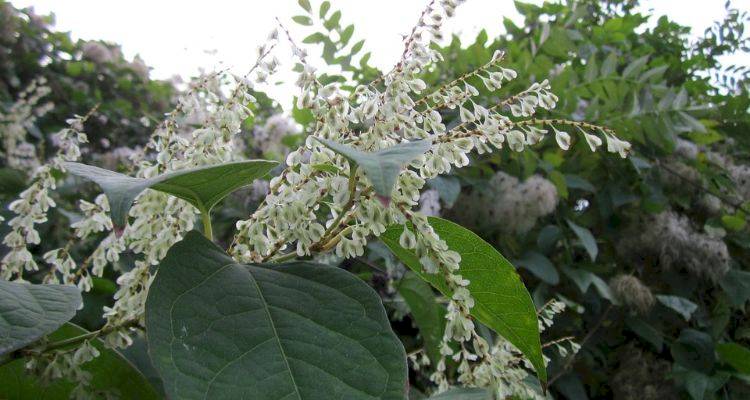
£4,000
Table of Contents
- How Much Does It Cost to Remove Japanese Knotweed?
- Labour Cost to Remove Japanese Knotweed & Timescales
- Factors That Impact Japanese Knotweed Removal Costs
- Types of Japanese Knotweed Treatments
- Emergency Japanese Knotweed Removal
- What's Involved in Removing Japanese Knotweed?
- Identifying Japanese Knotweed
- How to Get Rid of Japanese Knotweed Yourself
- What Does Japanese Knotweed Do?
- Japanese Knotweed Law and Legislation in the UK
- Checklist: Hiring a Japanese Knotweed Removal Specialist
How Much Does It Cost to Remove Japanese Knotweed?
Japanese knotweed is one of the most damaging and toughest plants in the entire world. It can grow at a menacing rate and can be incredibly challenging to eradicate.
Japanese knotweed can grow almost anywhere, including underground, up to a depth of 3 metres and can have a horizontal spread in any direction up to up to 7 metres. Its strength can cause damage to concrete, house foundations, and patios – there are no barriers that this pest can’t take over.
If you discover Japanese knotweed growing somewhere around your property, it is essential that you act fast. If you leave this pest for too long, it can begin to grow underneath your home and even through your walls and floors.
There are a number of different types of Japanese knotweed removal and prices can vary from £1,000 all the way up to £20,000 for an average-sized garden in the UK. These prices will depend on the size of the infestation, the ease of access to your home, and the type of removal that you choose to carry out.
I've been told I may have Japanese knotweed in the back garden, how do I go about checking this and then removing it? Do I need a specialist?
Make sure they are registered, as if someone removes it and doesn't have a licence to do so, then YOU would also be fined too, along with the company that removed it."
Japanese Knotweed Removal Prices
Below is a table of prices you should expect to pay for various parts of a Japanese knotweed removal and treatment job.
| Size of Treatment Area | Minor (<49m²) | Intermediate (50m² – 99m²) | Major (100m² – 499m²) | Severe (500m² – 1000m²) |
|---|---|---|---|---|
| Herbicide Treatment | £1,000 – £2,950 | £3,000 – £4,950 | £3,950 – £6,950 | £5,000 – £12,000 |
| Sifting and Screening | £1,750 – £4,950 | £5,000 – £9,950 | £10,000 – £35,000 | £35,000 – £50,000 |
| Excavation and Root Barriers | £1,750 – £4,950 | £5,000 – £9,950 | £10,000 – £35,000 | £35,000 – £50,000 |
| Excavation and on-site relocation with ongoing herbicide treatment | £4,000 – £9,500 | £9,000 – £14,950 | £11,000 – £20,000 | £15,000 – £30,000 |
| On-site Burial | £4,000 – £14,950 | £10,000 – £20,000 | £15,000 – £35,000 | £30,000 – £70,000 |
| Full Excavation and Removal | £4,000 – £20,000 | £14,000 – £39,000 | £35,000 – £120,000 | £100,000 – £200,000 |
In most domestic cases, a herbicide treatment is the easiest and cheapest solution to a Japanese knotweed problem.
Japanese Knotweed Removal Cost per m²
Gardens come in all different shapes and sizes. To better understand the costs for Japanese knotweed removal from your garden, we've broken down the prices by m².
| Treatment Type | Approximate Cost per m² |
|---|---|
| Herbicide Treatment | £20 – £60 |
| Excavation & Root Barriers | £50 – £100 |
| On-site Burial | £80 – £200 |
| Full Excavation & Removal | £100 – £400 |
These prices are approximate and can vary depending on site accessibility, infestation severity, and additional labour costs.
Labour Cost to Remove Japanese Knotweed & Timescales
Identifying and removing Japanese knotweed is not an easy job and is one that should be carried out by a professional.
A specialist Japanese knotweed contractor will charge around £20 to £50 per hour.
The contractor will need to attend the site to identify if the weed is actually Japanese knotweed and then they will conduct a plan with you to remove it. The removal process can take a very long time to get rid of it completely.
The first stage will usually involve some removal and treatments with herbicide, and this part of the job will usually last less than a day for small areas such as domestic homes.
This will usually not eradicate the problem completely. You should expect to have to have follow-up treatments for up to five years before your knotweed problem is completely taken care of.
Factors That Impact Japanese Knotweed Removal Costs
There are a number of things that may affect the cost of a Japanese knotweed removal job. Below is a list of things that may affect the cost of this type of job.
Size of the Affected Area
The size of the affected area will greatly affect the cost of your Japanese knotweed removal. For example, a herbicide treatment on an area below 49m² will cost around £1,000 to £2,950 whereas a herbicide treatment on a 500+m² area will cost around £5,000 to £12,000. So, you can see the size of the area can have a big difference in the cost of removing your Japanese knotweeds.
Type of Treatment Needed
The type of treatment needed in an area can affect the overall cost of the job. For example, a herbicide on an area below 49m² will cost around £1,000 to £2,950 whereas a full excavation and removal on the same size of area will cost around £4,000 to £20,000. So, you can see from this that the type of job required can greatly affect the overall cost of the job at hand.
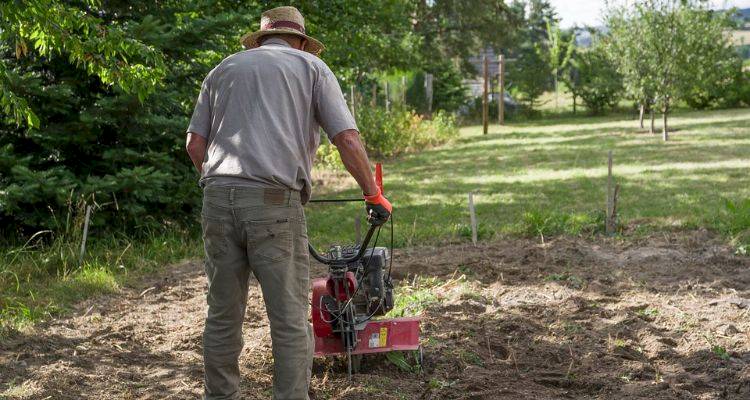
Ease of Access to the Area
The cost can be affected by the ease of access to the area. If your property is located in an area that is difficult to access, this can result in the job taking a lot longer, and the labour costs will be greatly increased. On average, a Japanese knotweed specialist will charge around £20 to £50 per hour, and so additional time on the job can really add up.
Extent of Japanese Knotweed Growth
Similarly, the extent of the Japanese knotweed growth can affect the overall cost of the job. The more knotweed that needs to be treated, the longer the job is going to take, and therefore, the higher the overall cost will end up being due to the extra time and work needed.
Types of Japanese Knotweed Treatments
There are a number of different treatments for Japanese knotweed. Below is a list of the different types of treatments that can tackle a Japanese knotweed problem.
Herbicide Treatment
A herbicide treatment is the most cost-effective Japanese knotweed treatment. For an average domestic garden, you should expect to pay around £1,000 to £2,950 for a herbicide treatment.
The treatment involves carefully and methodically managed visits where a chemical is sprayed onto and injected into the knotweed over a sustained period of time. This exhausts the plant and prevents it from spreading.
Excavation
Excavation is the fastest Japanese knotweed removal process, but it is also much more expensive than a herbicide treatment. For an on-site excavation with root barriers put in place to prevent the growth, you would be looking at paying around £1,750 to £4,950 for the work to be carried out on an average-sized garden.
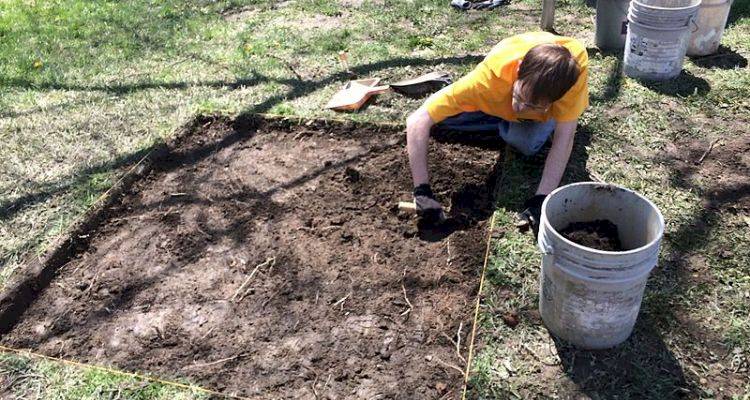
The job involves using plant machinery to physically pull out the infected soil. Any traces of knotweed or infected soil will then be disposed of in a controlled process.
Sifting and Screening
Excavation can be a very large and costly job. The less contaminated the soil is that you have, the lower the costs will be for an off-site burial.
This is where a sifting and screening job comes in handy. For an average-sized domestic garden, sifting and screening will cost around £1,750 to £4,950.
The job involves using plant machinery to scrape back a thin layer of soil which is then sifted or screened by a Japanese knotweed surveyor. This involves digging out infested soil and screening it to remove the rhizomes.
The screened soil can then be re-used on a different area of the site, reducing the amount of waste that needs to be disposed of.
Burial on Site
An on-site burial saves the costs of having the infected soil and knotweed disposed of at a specialist landfill. Instead, the soil is buried on-site. The cost for an on-site burial on an average-sized domestic garden will cost around £4,000 to £14,950.
The job involves removing all of the infested soil and knotweed present and then burying these waste products at a different area on the site to a depth of at least five metres.
This is a more cost-effective method than having the waste transported to be disposed of off-site.
Full Excavation and Removal Off Site
Sometimes the only way to remove your knotweed problem is to get rid of it through an excavation and removal of the waste off-site. A full excavation and removal off-site for an average-sized garden will cost around £4,000 to £20,000.
The process involves digging out and removing all of the existing knotweed and digging out any affected soil. These waste products will then be taken away and disposed of in a controlled manner at a specialist location sway from the site.
Emergency Japanese Knotweed Removal
Japanese knotweed damage can be devastating if left untreated. For people who are selling their homes, it is important that you remove Japanese knotweed before you attempt to sell your home, as this pest could prevent a sale from going through.
An emergency Japanese knotweed removal will usually involve a full excavation and either a burial on-site or removal off-site. This is the fastest method for controlling and removing your Japanese knotweed invasion.
These types of excavation usually cost somewhere between £4,000 and £20,000 for an average-sized garden in the UK. The job will usually take just 1 to 2 days, depending on the extent of growth and the ease of access to your property.
With these methods, it is quite easy to get rid of your Japanese knotweed infestation quickly.
In times of emergency or where you really want to get your Japanese knotweed problem under control and diminished quickly, excavation is the best route, and most companies will offer a fast turnaround for this kind of work.
What's Involved in Removing Japanese Knotweed?
Japanese knotweed must be completely eradicated to ensure it doesn’t return. Removing the root strands is a difficult task that often requires the use of mechanical diggers, which professionals typically hire for around £200 to £300 per day.
All materials, including contaminated soil, must be safely disposed of. As Japanese knotweed is classified as controlled waste in the UK, a professional will transport it to a specialist licensed landfill site.
The most common approach used by professional contractors is herbicide treatment. The process is typically carried out as follows:
Step One
The removal specialist will begin with a full risk assessment of the surrounding area. They evaluate any nearby schools, playgrounds, communal areas, or water sources such as rivers, streams, canals, or ponds that could be affected by herbicide drift. Neighbours may be notified in advance to keep pets and children indoors during treatment.
An action plan is drawn up to outline all steps. The optimal treatment period is between late spring and early autumn, when the plant is in full growth.
Step Two
They will ensure they have the necessary safety equipment, including:
- Overalls
- Safety mask
- Gloves
- Face Shield
- Sheets and Tarpaulins
- Rubble Sacks
Step Three
Weather conditions are checked before treatment. Herbicides used on knotweed can affect other plant life, so work is scheduled on dry, calm days to minimise the risk of drift.
Step Four
For herbicide application, professionals typically use a garden sprayer or specialised tools near sensitive areas such as water sources, schools, or playgrounds. In some cases, herbicide may be applied using rollers, cloths, sponges, or brushes to protect surrounding plants and soil. Some of the herbicide is often injected directly into the stems using professional injection tools.
Step Five
After treatment, any cut or removed knotweed is carefully bagged in sturdy plastic rubble sacks and taken to a licensed landfill site. Some UK councils offer specialist collection services, which contractors may coordinate with where available.
Step Six
Complete eradication requires repeated treatments. Professional contractors typically repeat herbicide applications 2 to 3 times per year over 3 to 5 years until the knotweed is fully eliminated and does not regrow.
Identifying Japanese Knotweed
Japanese knotweed is a type of weed that spreads incredibly rapidly. It grows extremely high and can penetrate through extremely tough materials, including flooring, walls, and roofs.
The weed arrived in the UK from Japan in the mid-nineteenth century by a German-born botanist named Phillipp von Siebold who discovered the plant growing along the side of volcanoes.
It was initially praised for being a beautiful plant and for its potential to provide feed for animals. It was originally sold at nurseries for people to plant as they wished.
It spread through the country by people sharing cuttings of the plant as well as through movement of water and soils during construction and when building new roads. Nowadays, it is known as a nuisance as it can cause destructive damage to properties and take over large areas of land.
Japanese knotweed is a unique-looking plant that has a few specific features that make it easier to identify it.
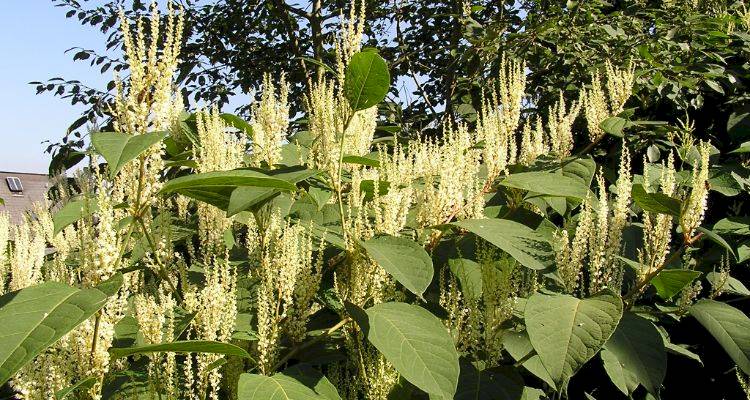
In the springtime, purple-reddish coloured shoots begin to emerge from crimson-pink buds that are on the ground level. These shoots grow incredibly quickly, and by summertime, these large bamboo-like shoots reach up to 7ft tall.
The bamboo-like shoots have noticeable purple spots on them, and they produce branches from nodes all the way along. The leaves that grow off the branches are heart-shaped and grow up to 14cm in length. They also have a noticeable zig-zag pattern along the stems.
When it first breaks through the ground, you will notice red-coloured shoots. This may be a good early indication that you have knotweeds growing in your area.
The plant will begin to bloom around the end of July, and clusters of cream-coloured flowers will begin to show. These flowers can attract a lot of bees.
As autumn arrives, the plant dies back, and you are left with brown stems. If you notice any of the above characteristics within a plant in your area, you may have a Japanese knotweed problem.
If you are still unsure, you may want to hire a professional to inspect your area so that you can treat your weed problem as early as possible.
How to Get Rid of Japanese Knotweed Yourself
Removing Japanese knotweed can be very tricky, particularly if there is a significant infestation. It is strongly recommended that you hire a professional contractor to handle the removal. Professionals have the expertise, equipment, and legal knowledge to carry out the job safely and ensure all waste is disposed of at licensed landfill sites.
For very small infestations, homeowners may consider a controlled herbicide treatment themselves. Glyphosate-based products are generally used for controlling Japanese knotweed, with a typical 5L bottle costing around £30 to £50.
While the cost of a DIY treatment is lower than hiring a professional, there are risks involved, including potential harm to surrounding plants, soil contamination, and legal compliance issues. For an average-sized garden with a medium infestation, disposable safety gear may cost £50 to £70, herbicide £100 to £150 per year, and a sprayer £18 to £25.
Even when attempting small-scale treatment yourself, it is still strongly recommended to consult a professional to assess the site and provide guidance. In most cases, hiring a dedicated Japanese Knotweed removal specialist is the safest and most effective way to eradicate the plant.
Are you obliged to hire a professional if there is Japanese knotweed in your garden? I am aware that you must not cut it, but what else must I do and must I not do if it ever pops up?
What Does Japanese Knotweed Do?
Japanese knotweed can grow by up to 20cm per day. This is extremely fast growth, which is why it can easily and rapidly take over an area.
Japanese knotweed can grow through concrete and tarmac, and the roots of this ferocious weed can grow up to 3m deep in the ground.
There are no natural predators to tackle this type of weed. This means that it can continue to grow uninterrupted. The sheer height of the plant can block out sunlight from neighbouring plants, causing them to die through lack of sunlight.
Japanese Knotweed Law and Legislation in the UK
Japanese knotweed is an invasive species of plant and, therefore, it is the responsibility of the landowner to ensure that this plant doesn’t spread into neighbouring lands or into the wild.
There is no legal obligation to remove the plant as long as you are not encouraging the spread into neighbouring lands.
If you are using pesticides to treat your knotweed problem, there are some rules set in place for control. You must ensure that you take all of the necessary precautions in order to protect human lives, animal lives, and plant lives.
By law, anyone who is using a pesticide professionally must have the relevant certificate of the safe use of pesticides. They must also be fully trained in the application process of herbicides.
There are some rules in place regarding off-site disposal of Japanese knotweed. Disposal of Japanese knotweed must be carried out by a licensed waste carrier in a licensed facility. Transfer notes must be filled out and stored whenever Japanese knotweed is disposed of in one of these facilities.
In 2013, the UK government brought out new legislation that states that anyone who fails to control Japanese knotweed from spreading could receive an anti-social behavioural order.
This means that failure to control the spread of Japanese knotweed on your land could result in it being seen as a criminal offence. You could be fined up to £20,000 if prosecuted.
Checklist: Hiring a Japanese Knotweed Removal Specialist
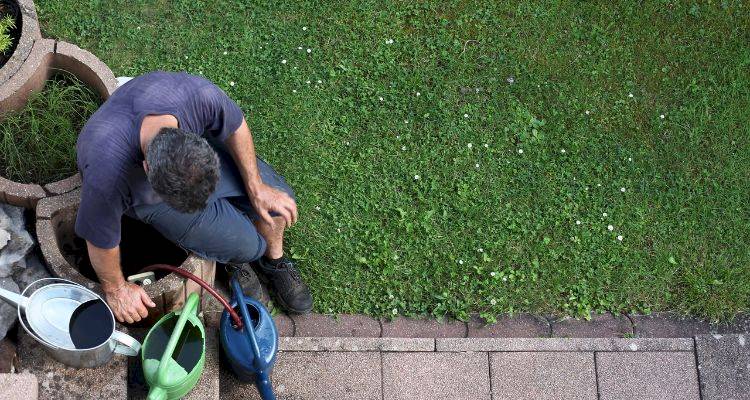
There are a number of things to consider when looking for the right company to carry out work on removing your Japanese knotweed.
Below is a list of things to look out for when choosing the right Japanese knotweed removal contractors for the job:
- How much experience does the company have in removing Japanese knotweed?
- What methods of removal does the company offer?
- What methods of disposal does the company offer?
- Does the company offer any guarantees with their work?
- What is included in the quote?
- Be sure to get at least three quotes so you can ensure you are getting a good price for the job at hand.
- Ask for a breakdown of costs in the quote so you can ensure you are getting a good price for each of the different elements of the job.




